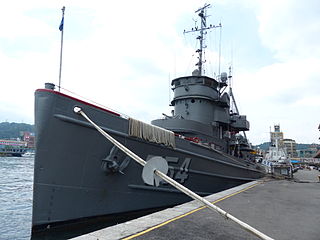
USS Baltimore (CA-68) was the lead ship of her class of heavy cruiser, the fifth ship of the United States Navy named after the city of Baltimore, Maryland.

USS Achomawi (AT-148/ATF-148) was an Abnaki-class fleet ocean tug in the service of the United States Navy, and was named for the Achomawi tribe of Native Americans.

USS Geneva (APA-86) was a Gilliam-class attack transport that served with the United States Navy from 1945 to 1947. She was scrapped in 1966.

USS Ottawa (AKA-101) was a Tolland-class attack cargo ship in service with the United States Navy from 1945 to 1947. She was sold into commercial service and was lost in 1951.

USS Pandemus (ARL-18) was one of 39 Achelous-class landing craft repair ships built for the United States Navy during World War II and was in commission from 1945 to 1946 and from 1951 to 1968. Named for Pandemus, she has been the only U.S. Navy vessel to bear the name.

USS Sheldrake (AM-62/AGS-19) was an Auk-class minesweeper built for the United States Navy during World War II. The ship was named after the sheldrake duck. The ship earned four battle stars during World War II. She was converted to a survey ship and re-designated AGS-19 in 1952 and remained in commission until 1968. She was sold for scrap in 1971.
USS Heed (AM-100) was an Auk-class minesweeper built for the United States Navy during World War II. She earned five battle stars for her World War II service. She was recommissioned during the Korean War. She was placed in reserve in 1954 and remained there until struck from the Naval Vessel Register in 1967.

USS Pursuit (AM-108) was an Auk-class minesweeper acquired by the United States Navy for the dangerous task of removing mines from minefields laid in the water to prevent ships from passing.
USS PCS-1465 was a PCS-1376-class minesweeper built for the United States Navy during World War II. Late in the war she was renamed and reclassified Minah (AMc-204), and in the 1950s reclassified first as AMCU-14 and later as MHC-14. Named for the myna under a variant spelling, she was the only U.S. Navy ship of that name.

USS Riverside (APA-102) was a Bayfield-class attack transport in service with the United States Navy from 1944 to 1946. In 1948, she was sold into commercial service. She sank in Smyth Channel, Chile, in 1968.

USS Shelikof (AVP-52) was a United States Navy Barnegat-class small seaplane tender in commission from 1944 to 1947 and from 1952 to 1954.

USS Enoree (AO-69) was a Chiwawa-class oiler constructed for the United States Navy during World War II. She was the only U.S. Navy ship named for the Enoree River in South Carolina.

USS James M. Gilliss (AMCU-13/YMS-262) was a YMS-1-class minesweeper of the YMS-135 subclass named after James Melville Gilliss, a US naval officer credited with establishing the US Naval Observatory.

USS Custer (AP-85/APA-40) was a Bayfield-class attack transport in service with the United States Navy from 1943 to 1946. She was sold into commercial service in 1948 and was scrapped in 1973.

USS Rockwall (APA-230) was a Haskell-class attack transport that served in the United States Navy from 1945 to 1947 and from 1951 to 1955. She was scrapped in 1984.

USS William Ward Burrows was a transport ship that saw service with the United States Navy in World War II. The ship was the former Grace Steamship Company liner MV Santa Rita by Burmeister & Wain and launched in 1929 at Copenhagen, Denmark.

USS Kinzer (APD-91), ex-DE-232, was a United States Navy high-speed transport in commission from 1944 to 1946.

USS Rednour (APD-102) was a Crosley-class high speed transport that served in the United States Navy from 1945 to 1946. In December 1969, she was transferred to Mexico and served under the name Chihuahua until July 2001.

USS Tollberg (APD-103) was a United States Navy high-speed transport in commission from 1945 to 1946. In 1965, Tollberg was transferred to Colombia and served as ARC Almirante Padilla (DT-03) until being stricken and scrapped in 1973.

USS Pavlic (APD-70) was built by Dravo Corporation at Pittsburgh, Pennsylvania as a Buckley-class destroyer escort. Pavlic was launched 18 December 1943 and towed to Texas for refitting as a United States Navy high-speed transport. Pavlic was in commission from 1944 to 1946, serving in the Okinawa campaign as a radar picket ship. Pavlic was decommissioned 15 November 1946. After more than 20 years of inactivity in reserve, she was stricken from the Navy List on 1 April 1967. On 1 July 1968, she was sold for scrapping to North American Smelting Company.


















